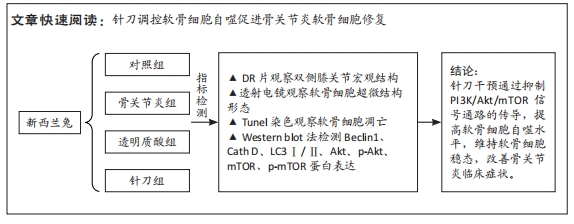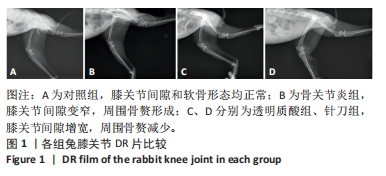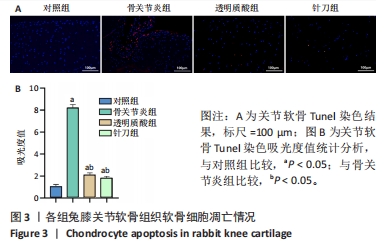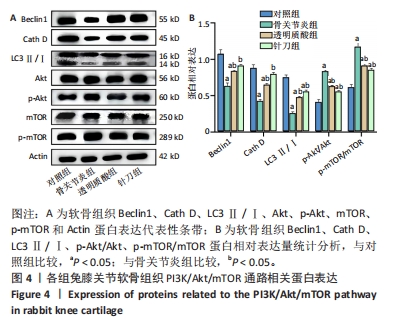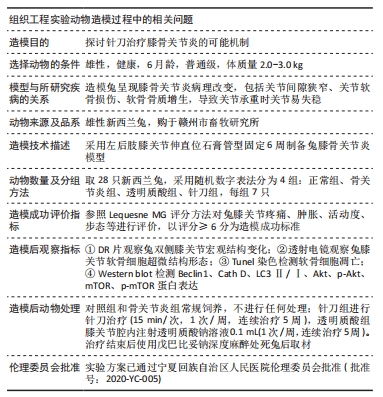[1] DE ROOVER A, ESCRIBANO-NUNEZ A, MONTEAGUDO S, et al. Fundamentals of osteoarthritis: Inflammatory mediators in osteoarthritis. Osteoarthritis Cartilage. 2023;31(10):1303-1311.
[2] JAIN L, BOLAM S M, MONK AP, et al. Differential Effects of Hypoxia versus Hyperoxia or Physoxia on Phenotype and Energy Metabolism in Human Chondrocytes from Osteoarthritic Compared to Macroscopically Normal Cartilage. Int J Mol Sci. 2023;24(8):7532.
[3] Fujii Y, Liu L, Yagasaki L, et al. Cartilage Homeostasis and Osteoarthritis. Int J Mol Sci. 2022;23(11):6316.
[4] WANG J, ZHANG Y, CAO J, et al. The role of autophagy in bone metabolism and clinical significance. Autophagy. 2023;19(9):2409-2427.
[5] LUO P, GAO F, NIU D, et al. The Role of Autophagy in Chondrocyte Metabolism and Osteoarthritis: A Comprehensive Research Review. Biomed Res Int. 2019;2019:5171602.
[6] SUN K, LUO J, GUO J, et al. The PI3K/AKT/mTOR signaling pathway in osteoarthritis: a narrative review. Osteoarthritis Cartilage. 2020; 28(4):400-409.
[7] 郭长青,司同,温建民,等.针刀松解法改善膝骨关节炎疼痛症状的随机对照临床研究[J].天津中医药,2012,29(1):35-38.
[8] 王翔,刘顺怡,石瑛,等.针刀松解术治疗膝骨关节炎的临床观察[J].中国骨伤,2016,29(4):345-349.
[9] 张雷,危慕彬,刘爱峰.小针刀与针刺治疗膝骨性关节炎临床疗效Meta分析[J].天津中医药,2019,36(3):253-257.
[10] 刘福水,金德忠,吴翔.针刀与针灸治疗膝骨关节炎疗效比较的Meta分析[J].中国组织工程研究,2012,16(44):8235-8239.
[11] VIDEMAN T. Experimental osteoarthritis in the rabbit: comparison of different periods of repeated immobilization. Acta Orthop Scand. 1982;53(3):339-347.
[12] SHI X, YU W, WANG T, et al. Electroacupuncture alleviates cartilage degradation: Improvement in cartilage biomechanics via pain relief and potentiation of muscle function in a rabbit model of knee osteoarthritis. Biomed Pharmacother. 2020;123:109724.
[13] 张良志,刘洪,修忠标.基于经筋理论针刀治疗膝骨性关节炎疗效的Meta分析[J].中国民族民间医药,2020,29(8):54-57.
[14] DU X, LIU ZY, TAO XX, et al. Research Progress on the Pathogenesis of Knee Osteoarthritis. Orthop Surg. 2023;15(9):2213-2224.
[15] GENG R, LI J, YU C, et al. Knee osteoarthritis: Current status and research progress in treatment (Review). Exp Ther Med. 2023;26(4): 481.
[16] LV X, ZHAO T, DAI Y, et al. New insights into the interplay between autophagy and cartilage degeneration in osteoarthritis. Front Cell Dev Biol. 2022;10:1089668.
[17] TIAN Z, ZHANG X, SUN M. Phytochemicals Mediate Autophagy Against Osteoarthritis by Maintaining Cartilage Homeostasis. Front Pharmacol. 2021;12:795058.
[18] SASAKI H, TAKAYAMA K, MATSUSHITA T, et al. Autophagy modulates osteoarthritis-related gene expression in human chondrocytes. Arthritis Rheum. 2012;64(6):1920-1928.
[19] BOUDERLIQUE T, VUPPALAPATI KK, NEWTON PT, et al. Targeted deletion of Atg5 in chondrocytes promotes age-related osteoarthritis. Ann Rheum Dis. 2016;75(3):627-631.
[20] ZHANG Y, VASHEGHANI F, LI YH, et al. Cartilage-specific deletion of mTOR upregulates autophagy and protects mice from osteoarthritis. Ann Rheum Dis. 2015;74(7):1432-1440.
[21] MITRA A, RAYCHAUDHURI SK, RAYCHAUDHURI SP. IL-22 induced cell proliferation is regulated by PI3K/Akt/mTOR signaling cascade. Cytokine. 2012;60(1):38-42.
[22] CARAMES B, TANIGUCHI N, OTSUKI S, et al. Autophagy is a protective mechanism in normal cartilage, and its aging-related loss is linked with cell death and osteoarthritis. Arthritis Rheum. 2010;62(3):791-801.
[23] WANG S, DENG Z, MA Y, et al. The Role of Autophagy and Mitophagy in Bone Metabolic Disorders. Int J Biol Sci. 2020;16(14):2675-2691.
[24] MIJANOVIC O, PETUSHKOVA AI, BRANKOVIC A, et al. Cathepsin D-Managing the Delicate Balance. Pharmaceutics. 2021;13(6):837.
[25] PENA-MARTINEZ C, RICKMAN A D, HECKMANN BL. Beyond autophagy: LC3-associated phagocytosis and endocytosis. Sci Adv. 2022;8(43): n1702.
[26] 佘泽宇,夏帅,卢曼,等.针刀对膝关节骨关节炎兔软骨PINK1/Parkin通路介导的线粒体自噬的影响[J].针刺研究,2023,48(9): 898-905.
[27] 卢曼,黄小双,孟德鸿,等.针刀对膝关节骨关节炎大鼠mTOR/Atg/ULK1/Beclin-1轴及软骨细胞自噬的影响[J].中国针灸,2022,42(1): 59-65.
[28] 刘晶,曾维铨,林巧璇,等.基于自噬及凋亡调控探讨针刀对膝关节骨关节炎兔软骨的保护作用[J]. 针刺研究,2022,47(12):1080-1087.
[29] BRONSTONE A, NEARY JT, LAMBERT TH, et al. Supartz (Sodium Hyaluronate) for the Treatment of Knee Osteoarthritis: A Review of Efficacy and Safety. Clin Med Insights Arthritis Musculoskelet Disord. 2019;12:71465557.
[30] RUTJES AW, JÜNI P, DA COSTA BR, et al. Viscosupplementation for osteoarthritis of the knee: a systematic review and metaanalysis. Ann Intern Med. 2012;157(3):180-191.
[31] TSCHOPP M, PFIRRMANN C, FUCENTESE SF, et al. A Randomized Trial of Intra-articular Injection Therapy for Knee Osteoarthritis. Invest Radiol. 2023;58(5):355-362.
|
